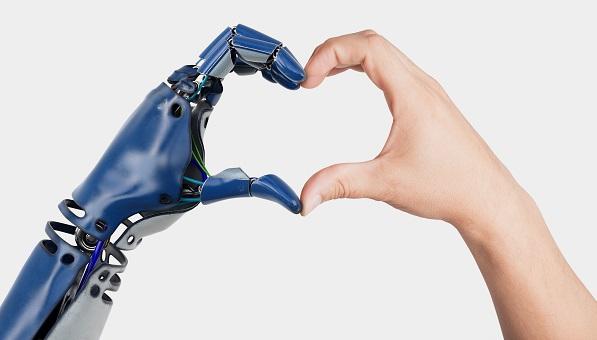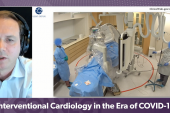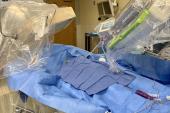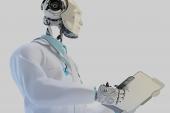Better Success With Next-Generation Robotic PCI: PRECISION GRX
Less radiation and back pain are welcome, along with clinical and technical success, but hospitals will need to weigh costs.

“[I]f you work in the cath lab for more than 15 years, you have significant occupational hazards, both orthopedic related, as well as associated with radiation,” said Ehtisham Mahmud, MD (University of California, San Diego), in his presentation yesterday at the Society for Cardiovascular Angiography and Interventions (SCAI) 2021 Scientific Sessions. Mahmud said data from the PRECISE and RAPID studies indicate that operators who sit at a cockpit without their lead and conduct PCI robotically for either coronary or peripheral interventions can reduce their radiation exposure by as much as 95%. However, while first-generation systems were demonstrated to be safe and effective, their use has been limited by inability to control the guide catheter and by experience primarily with ACC/AHA lesion types A and B1, he added.
Whereas in previous generations, technical success rates were around 80%, in the 980-patient PRECISION GRX study these latest data indicate that the rate has now been improved to 90%, Mahmud said. The advances “support robotic PCI being a viable option for addressing both the orthopedic risks and radiation associated risks for interventional cardiologists,” he said. Future developments are likely to include telecommunication for remote robotic PCI, over-the-wire platforms to allow for chronic total occlusions (CTOs) and atherectomies to be done fully in robot mode, and a second robotic drive for bifurcation lesions.
In response to a question from session co-moderator Steven J. Yakubov, MD (OhioHealth Heart & Vascular Physicians, Columbus, OH), about proficiency with the robotic system, Mahmud said it takes an operator on average about 25 procedures to become truly facile in using it.
Panelist Megan Coylewright, MD (Erlanger Health System, Chattanooga, TN), welcomed the idea of robotic PCI for improving operator health and career longevity, saying it offers a “great opportunity for us to reduce the cervical and lumbar issues that we see in our mentors.” However, she said, having the systems become commonplace will be a challenge that depends on individual hospital systems willingness and resources.
“I couldn't agree more about orthopedic and radiation associated issues for operators in a field where things are getting increasingly complex in terms of time spent on procedures as we expand into structural and more complex peripheral endeavors,” added panelist Jay Giri, MD (Hospital of the University of Pennsylvania, Philadelphia). “I would say the cost considerations seem to be paramount in the current era, even in health systems that may be viewed as pretty well off.”
PRECISION GRX Results
For the single-arm PRECISION GRX registry, Mahmud and colleagues enrolled CAD patients from 20 centers in the United States and India. The robotic system studied was the second-generation robotic CorPath GRX platform (Corindus), which has operator controls for the balloon or stent, guidewire, and guide catheter. Indications for PCI were primarily ACS (31.6%), stable angina (29.1%), and positive stress test (25.7%). Of the 1,214 coronary lesions 14.3% were type A, 28.1% were B1, 21.6% were B2, and 36.1% were C. An average of 1.6 stents were used per case, and longest stent length was 39 mm.
Clinical success, a co-primary endpoint, was defined as procedure completion with < 30% residual stenosis in the absence of a MACE. This occurred in 98.2% of all treated lesions, with no statistical differences across lesion types. Technical success, the other co-primary endpoint, was defined as clinical success along with the absence of manual assistance or conversion. This was seen in 89.8% of all lesions. Technical success was higher in type A and B1 lesions (95.8% and 95.3%, respectively) than type B2 and C lesions (88.3% and 86.7%, respectively).
In 14.7%, manual conversion was required, and the vast majority of those were unplanned. The most common reasons for unplanned conversion were inability to advance the guidewire (4.5%) and inability to cross the lesion (4.6%). Robotic malfunctions occurred in 15 cases (1.5%), but were not associated with adverse clinical events.
In stratification by access site, clinical and technical success were 97.4% and 84.8%, respectively, for femoral approaches, while they were 98.1% and 87.6%, respectively, for radial approaches. High rates of clinical and technical success were seen across a spectrum of high-risk lesions (ostial, left main, moderate-to-severe calcification, and bifurcation). CTO lesions also had high rates of clinical and technical success (99.0% and 91.0%, respectively), but Mahmud noted that these typically required manual crossing prior to initiating treatment on the robotic system.
The need to first cross all CTOs manually raises the issue of whether it’s worth it to then switch over to the robotic platform.
“Once you've crossed it manually, there's still a lot of work that is often required, and for individual operators, they can then be seated table side not getting radiated,” Mahmud told TCTMD, adding that the robotic aspect is advantageous for long cases. “A large portion of the team does not need to be radiated as various device exchanges and the rest of the procedure are completed.”
Mahmud said that is being investigated currently and could serve to fill unmet needs, particularly in rural areas, where there is limited access to neurointerventionalists for acute stroke care. “You could imagine an approach where the interventional cardiologist gets access and helps facilitate local management while from a remote site,” he explained.
L.A. McKeown is a Senior Medical Journalist for TCTMD, the Section Editor of CV Team Forum, and Senior Medical…
Read Full BioSources
Mahmud E. Safety and efficacy of the second generation robotic-assisted system for percutaneous coronary intervention: final results of the multicenter PRECISION GRX study. Presented at: SCAI 2021. April 29, 2021.
Disclosures
- The study was funded by Corindus.
- Mahmud reports consulting for Boston Scientific, Abiomed, and Medtronic; serving as principal investigator for a study for Abbott (St. Jude); and as principal Investigator for a study for Cardiovascular Systems.





Comments